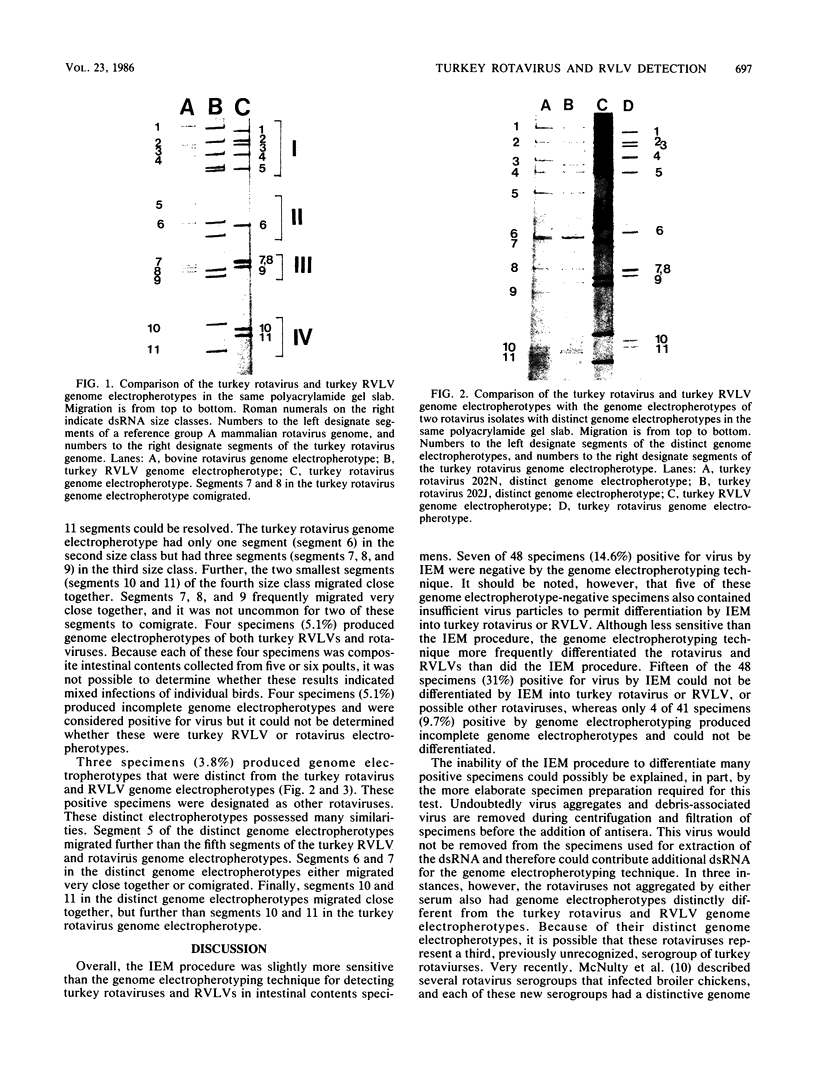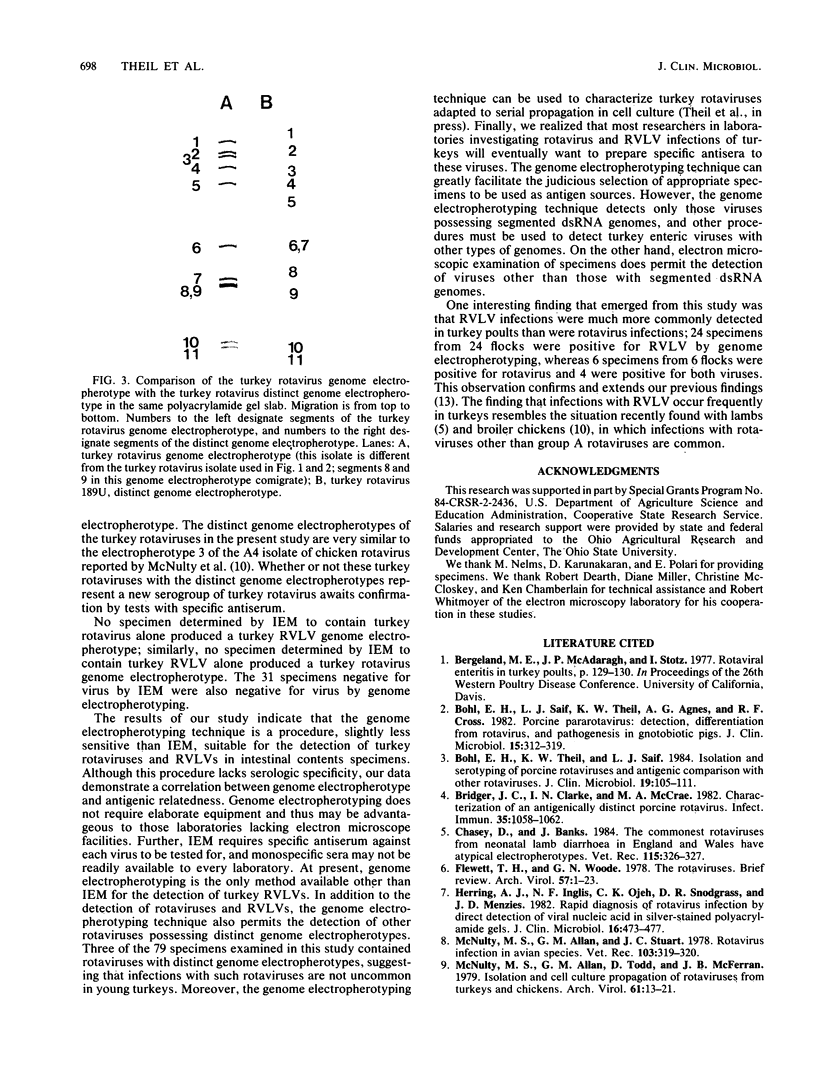Abstract
Seventy-nine intestinal contents specimens from 65 turkey flocks were examined for rotavirus and rotaviruslike virus (RVLV) by immune electron microscopy (IEM) and genome electropherotyping. The IEM procedure was slightly more sensitive in detecting these viruses; 7 of 48 specimens (14.6%) positive for virus by IEM were negative by the genome electropherotyping technique. The genome electropherotyping technique more readily differentiated the rotaviruses and RVLVs than did the IEM procedure; 15 of 48 specimens (31%) positive for virus by IEM could not be differentiated into rotavirus of RVLV, whereas only 4 of the 41 specimens (9.7%) positive by genome electropherotyping produced incomplete genome electropherotypes and could not be differentiated. Thirty-one specimens negative by IEM were also negative by genome electropherotyping. Specimens determined to contain only rotavirus by IEM produced only rotavirus genome electropherotypes. Likewise, specimens determined to contain RVLV alone by IEM produced only RVLV genome electropherotypes. Three specimens contained viruses morphologically resembling rotaviruses that were not aggregated by either the anti-turkey rotavirus serum or the anti-turkey RVLV serum and possessed genome electropherotypes distinct from those of the turkey rotavirus and RVLV. These rotaviruses may represent a third, previously unrecognized serogroup of turkey rotaviruses.
Full text
PDF




Images in this article
Selected References
These references are in PubMed. This may not be the complete list of references from this article.
- Bohl E. H., Saif L. J., Theil K. W., Agnes A. G., Cross R. F. Porcine pararotavirus: detection, differentiation from rotavirus, and pathogenesis in gnotobiotic pigs. J Clin Microbiol. 1982 Feb;15(2):312–319. doi: 10.1128/jcm.15.2.312-319.1982. [DOI] [PMC free article] [PubMed] [Google Scholar]
- Bohl E. H., Theil K. W., Saif L. J. Isolation and serotyping of porcine rotaviruses and antigenic comparison with other rotaviruses. J Clin Microbiol. 1984 Feb;19(2):105–111. doi: 10.1128/jcm.19.2.105-111.1984. [DOI] [PMC free article] [PubMed] [Google Scholar]
- Bridger J. C., Clarke I. N., McCrae M. A. Characterization of an antigenically distinct porcine rotavirus. Infect Immun. 1982 Mar;35(3):1058–1062. doi: 10.1128/iai.35.3.1058-1062.1982. [DOI] [PMC free article] [PubMed] [Google Scholar]
- Chasey D., Banks J. The commonest rotaviruses from neonatal lamb diarrhoea in England and Wales have atypical electropherotypes. Vet Rec. 1984 Sep 29;115(13):326–327. doi: 10.1136/vr.115.13.326. [DOI] [PubMed] [Google Scholar]
- Flewett T. H., Woode G. N. The rotaviruses. Arch Virol. 1978;57(1):1–23. doi: 10.1007/BF01315633. [DOI] [PMC free article] [PubMed] [Google Scholar]
- Herring A. J., Inglis N. F., Ojeh C. K., Snodgrass D. R., Menzies J. D. Rapid diagnosis of rotavirus infection by direct detection of viral nucleic acid in silver-stained polyacrylamide gels. J Clin Microbiol. 1982 Sep;16(3):473–477. doi: 10.1128/jcm.16.3.473-477.1982. [DOI] [PMC free article] [PubMed] [Google Scholar]
- McNulty M. S., Allan G. M., Stuart J. C. Rotavirus infection in avian species. Vet Rec. 1978 Sep 30;103(14):319–320. doi: 10.1136/vr.103.14.319-a. [DOI] [PubMed] [Google Scholar]
- McNulty M. S., Allan G. M., Todd D., McFerran J. B. Isolation and cell culture propagation of rotaviruses from turkeys and chickens. Arch Virol. 1979;61(1-2):13–21. doi: 10.1007/BF01320587. [DOI] [PubMed] [Google Scholar]
- McNulty M. S., Todd D., Allan G. M., McFerran J. B., Greene J. A. Epidemiology of rotavirus infection in broiler chickens: recognition of four serogroups. Arch Virol. 1984;81(1-2):113–121. doi: 10.1007/BF01309301. [DOI] [PubMed] [Google Scholar]
- Pedley S., Bridger J. C., Brown J. F., McCrae M. A. Molecular characterization of rotaviruses with distinct group antigens. J Gen Virol. 1983 Oct;64(Pt 10):2093–2101. doi: 10.1099/0022-1317-64-10-2093. [DOI] [PubMed] [Google Scholar]
- Saif L. J., Bohl E. H., Kohler E. M., Hughes J. H. Immune electron microscopy of transmissible gastroenteritis virus and rotavirus (reovirus-like agent) of swine. Am J Vet Res. 1977 Jan;38(1):13–20. [PubMed] [Google Scholar]
- Saif L. J., Saif Y. M., Theil K. W. Enteric viruses in diarrheic turkey poults. Avian Dis. 1985 Jul-Sep;29(3):798–811. [PubMed] [Google Scholar]
- Saif Y. M. Maintenance of a specific pathogen free turkey flock. Poult Sci. 1974 Mar;53(2):544–546. doi: 10.3382/ps.0530544. [DOI] [PubMed] [Google Scholar]
- Theil K. W., McCloskey C. M., Saif L. J., Redman D. R., Bohl E. H., Hancock D. D., Kohler E. M., Moorhead P. D. Rapid, simple method of preparing rotaviral double-stranded ribonucleic acid for analysis by polyacrylamide gel electrophoresis. J Clin Microbiol. 1981 Sep;14(3):273–280. doi: 10.1128/jcm.14.3.273-280.1981. [DOI] [PMC free article] [PubMed] [Google Scholar]
- Theil K. W., Saif L. J., Moorhead P. D., Whitmoyer R. E. Porcine rotavirus-like virus (group B rotavirus): characterization and pathogenicity for gnotobiotic pigs. J Clin Microbiol. 1985 Mar;21(3):340–345. doi: 10.1128/jcm.21.3.340-345.1985. [DOI] [PMC free article] [PubMed] [Google Scholar]
- Thouless M. E., Bryden A. S., Flewett T. H., Woode G. N., Bridger J. C., Snodgrass D. R., Herring J. A. Serological relationships between rotaviruses from different species as studied by complement fixation and neutralization. Arch Virol. 1977;53(4):287–294. doi: 10.1007/BF01315627. [DOI] [PubMed] [Google Scholar]
- Woode G. N., Bridger J. C., Jones J. M., Flewett T. H., Davies H. A., Davis H. A., White G. B. Morphological and antigenic relationships between viruses (rotaviruses) from acute gastroenteritis of children, calves, piglets, mice, and foals. Infect Immun. 1976 Sep;14(3):804–810. doi: 10.1128/iai.14.3.804-810.1976. [DOI] [PMC free article] [PubMed] [Google Scholar]
- Yason C. V., Schat K. A. Isolation and characterization of avian rotaviruses. Avian Dis. 1985 Apr-Jun;29(2):499–508. [PubMed] [Google Scholar]





